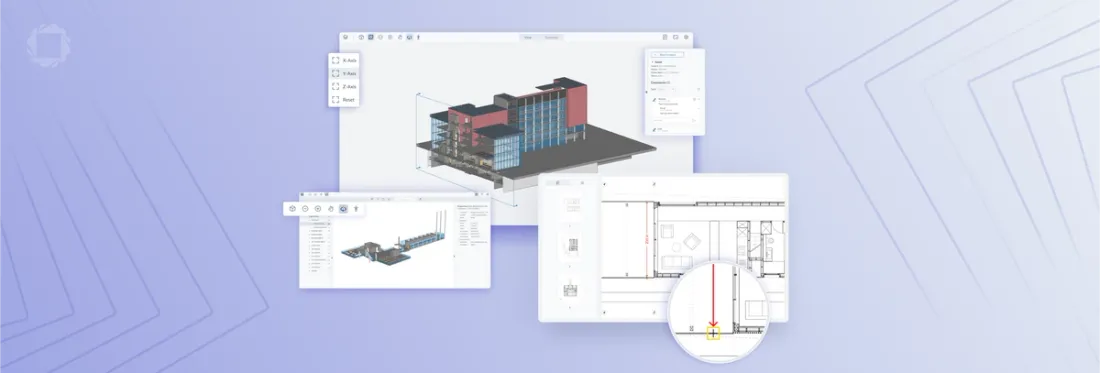Building a Digital Future: The Next Step in AEC Document Automation
By Nikki Manthey | 2023 Dec 02

5 min
Tags
aec
document automation
document generation
Summary: Automating AEC documents enhances efficiency, accuracy, and collaboration while ensuring compliance, cost savings, and faster project timelines, optimizing overall productivity in the industry.
Excellent documentation and processes are the cornerstone of success in many industries. This is especially true for architecture, engineering, and construction (AEC). In a bustling arena of complex projects, multiple stakeholders, strict budgets, stringent deadlines, and extensive regulation, every document can play a pivotal role in ensuring projects follow the blueprint.
Despite being one of the largest industries in the world with a global market size of US$8.9 billion in 2022, AEC is also one of the least digitized. This can lead to significant challenges around document workflows like generation at the required scale, lack of collaboration, and compliance issues.
Read on to learn more about common documentation challenges in AEC and how Apryse’s powerful document generation and management solutions can help bring your business into a digital future through automation.
Current AEC Digitization Challenges
The digital era’s rise has been swift and global. Technology has changed the way virtually everyone works; however, change doesn’t come quite as easily to certain sectors. Due to its scale, AEC has been slower to set a course towards digitization. Of course, size isn’t the only challenge this sector faces.
Resistance to Change
“We’ve always done it this way.” For an industry as steeped in tradition and established processes as AEC, this phrase is probably familiar. It’s also understandable – industry professionals have spent decades honing their craft and focusing on safety. There’s a feeling that new technology, including document processing solutions, will require significant retraining, a shift in perspective as in the transition from 2D to 3D, introduce safety concerns, or be costly to implement.
The Almighty Dollar
Despite the staggering dollar amounts associated with AEC, lower profit margins and lack of administrative resources are still present. Many businesses face significant financial roadblocks to covering the upfront cost of technology, even if it results in savings down the road.
A Project-Based Mindset
One of the reasons companies may be hesitant to invest in digitization is the bespoke nature of many AEC projects. Solutions are often tailored to a site’s specific environment, regulatory landscape, client needs, and a variety of other considerations. This can make it difficult to adopt business- or industry-wide digital standardization practices.
Extensive Regulation
Rigorous building codes and strict regulations are the norm in AEC. However, those codes and regulations can vary widely by location, making it difficult for companies operating in multiple geographical regions to standardize products, processes, and digital workflows.
Despite these challenges, the industry is poised to gain significant benefits from digitization. And one fantastic place to start digital transformation is document automation and processing.

Why Automate? The Details Are in the Documents
From start to finish, an AEC project is driven by documentation. Documents provide all stakeholders insight into a project’s progress and can be as diverse and complex as the project itself.
Here's a look at common document types associated with AEC projects:
- Drawings and blueprints: This includes architectural drawings, engineering drawings, technical specifications, aesthetic information, and more.
- Project proposals and reports: Proposals cover topics like project scope, timelines, and cost. Reports provide progress updates, identify any issues, and track resolutions to those issues.
- Contracts and legal agreements: These documents include agreements with subcontractors, suppliers, clients, and consultants. They outline responsibilities and financial obligations.
- Compliance documents: Building codes and environmental regulations vary by market, so it’s essential to cover aspects like permits, impact assessments, and safety guidelines.
- Communication and collaboration data: This includes meeting minutes, documentation covering critical decisions, email correspondence, project updates, and more.
Generating AEC documents at scale can be demanding for several reasons. For example, project complexity and strict regulations can make it difficult to efficiently meet compliance standards. In addition, manual processes can be time consuming and resource-intensive. Solutions for automated document generation like Fluent can significantly streamline workflows and address other documentation challenges.
AEC Document Challenges and Solutions
Complex issues don’t always require complex solutions. At least, not when it comes to document generation and processing. Here are some recurring challenges faced by AEC professionals, and a quick overview of easy-to-use Apryse tools that can help.
Manual Document Generation Processes
In an industry with strict deadlines, any delays could result in financial repercussions. Talent recruitment and retention is an ongoing issue in AEC, so many firms find themselves without the resources for manual document generation and processing. Plus, doing things manually is generally more time-consuming, inefficient, costly, and prone to errors.
Enter Fluent, Apryse’s solution for automating high-volume document generation. You can deploy this flexible, self-hosted engine in one or multiple environments to automatically generate millions of documents tailored to a project’s needs. Fluent helps you save time and scale up the creation of business-critical documents using fewer resources, while reducing errors and ensuring documentation doesn’t become a roadblock to project completion.
Compliance
AEC documentation is governed by a host of regulations and standards, for example, ISO 19650, which covers management of information using Building Information Modeling (BIM). More broadly, many jurisdictions have also mandated PDF/UA accessibility. PDF/UA standards improve document accessibility for people who use assistive technology to access content.
Though PDF/UA applies to all documentation, it’s particularly relevant for AEC legal and compliance documents, since things like contracts and permits need to be accessible to a wide range of stakeholders. How can you generate compliant documents quickly to ensure project timelines stay on track?
Apryse recently announced accessibility updates to Fluent, which enables companies to efficiently generate and manage PDF/UA compliant reports, templates, and more in high volumes.
Want to learn more about these updates and the future of PDF/UA? Be sure to check out our recent blog post.
To explore Fluent’s new features, watch this video:
Collaboration
To ensure a project is successful, it’s essential to gather feedback from stakeholders like architects, contractors, engineers, and more. However, effective collaboration across time zones and geographical regions is difficult at the best of times. This can be a barrier when it comes to updating documents and templates to ensure everyone is getting the right information at the right time, especially during the review and approval phase.
Fluent provides a central database for report templates and more, which enables people with approved access to quickly update templates anytime, from anywhere.
To learn how Apryse helped Drawboard improve real-time collaboration on all their documents, read our case study.
Audit Trail
Fluent is perfect for automating high-volume document generation, but it’s far from the only automation tool suited to AEC that Apryse offers. When it comes to documents like contracts, it’s important to track the who, what, where, when, and why of viewing and signing.
Xodo Sign enables you to store a detailed audit trail of every transaction, which is essential for accountability and compliance purposes. You can also automate eSignature workflows with a fully featured REST API.
Visit the Apryse website to explore more tools to help streamline AEC document workflows.
Start Automating Document Generation with Fluent Today
It’s time to take AEC into the digital era. If you’d like to see how Fluent can help automate your document generation workflows and contribute to your next project’s success, start a trial today. If you have questions or want to learn more, feel free to get in touch with our sales team.
Tags
aec
document automation
document generation

Nikki Manthey
Share this post



